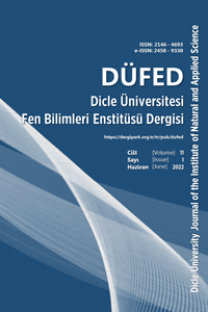Bazı Geofitlerin İndüktif Eşleşmiş Plazmalı Kütle Spektrometresi (ICP-MS) ile Makro ve Mikro Element Analizi
Macro and Micro Element Analysis of Some Geophytes by Inductively Coupled Plasma Mass Spectrometry (ICP-MS)
___
- Encyclopedia Britannica, URL: https://www.britannica.com/plant/Liliaceae (Erişim zamanı: Nisan, 15, 2020).
- L. Karakaya, Y. Akgül, and A. Nalbantsoy, “Chemical constituents and in vitro biological activities of Eremurus spectabilis leaves,” Natural Product Research, vol. 31, no. 15, pp. 1786–1791, 2017.
- M. Tosun, S. Ercisli, H. Ozer, M. Turan, H. Padem, T. Polat, E. Ozturk, and H. Kilicgun, “Chemical composition and antioxidant activity of foxtail lily (Eremurus spectabilis),” Acta Scientiarum Polonorum, Hortorum Cultus, vol. 11, no. 3, pp. 145–153, 2012.
- A. Cinar, S. T. Ay, F. Ayas, S. Karabak, N. Guzelsoy, and O. Ucurum, “Foxtail lilly (Eremurus spectabilis M. Bieb.) as priority species of biodiversity for food and nutrition project of turkey,” ANADOLU, J. of AARI, vol. 27, no. 2, pp. 69–73, 2017.
- Z. Tuzcu, G. Koclar, C. A. Agca, G. Aykutoglu, G. Dervisoglu, M. Tartik, E. Darendelioglu, Z. Ozturk, B. Kaya, and K. Sahin, “Antioxidant, antimicrobial and anticancer effects of different extracts from wild edible plant eremurus spectabilis leaves and roots,” International Journal of Clinical and Experimental Medicine, vol. 10, no. 3, pp. 4787–4797, 2017.
- D. Çakmak, C. Karaoğlu, M. Aasim, C. Sancak, and S. Özcan, “Advancement in protocol for in vitro seed germination, regeneration, bulblet maturation, and acclimatization of fritillaria persica,” Turkish Journal of Biology, vol. 40, no. 4, pp. 878–888, 2016.
- M. Koçyiğit, U. Rastgeldi, and E. Kaya, “Cytotaxonomical analysis of eleven Turkish Fritillaria L. (Liliaceae)” IUFS Journal of Biology, vol. 75, no. 2, pp. 19–28, 2016.
- M. Tekşen and Z. Aytaç, “Akdeniz bölgesi (Türkiye) Fritillaria L. (Liliaceae) cinsinin revizyonu,” Turkish Journal of Botany, vol. 35, no. 5, pp. 447–478, 2011.
- M. T. Babaç, “Possibility of an information system on plants of south-west asia with particular reference to the turkish plants data service (TUBIVES),” Turkish Journal of Botany, vol. 28, no. 1–2, pp. 119–127, 2004.
- L. Behçet and M. Rüstemoǧlu, “Allium shirnakiense, sect. Melanocrommyum (Liliaceae), a new species from South-eastern Turkey,” Turkish Journal of Botany, vol. 36, no. 5, pp. 450–454, 2012.
- M. Firat, “The ethnobotanical usage of some east anatolian,” Manas Journal of Agricultural and Life Science, vol. 5, no. 1, pp. 80–86, 2015.
- M. Firat, F. A. Karavelioğulları, and A. Aziret, “Geophytes of east anatolia (Turkey),” Manas Journal of Agricultural and Life Science, vol. 5, no. 1, pp. 38–53, 2016.
- E. Yabalak and A. M. Gizir, “Evaluation of total polyphenol content, antioxidant activity and chemical composition of methanolic extract from allium kharputense freyn et. Sint. and determination of mineral and trace elements,” Journal of the Turkish Chemical Society, Section A: Chemistry, vol. 4, no. 3, pp. 691–691, 2017.
- D. Tuğruş, "Gaziantep’te atık sulardan etkilenen toprak ve bitkilerde eser element (Cu, Co, Mn ve Zn) ve Fe konsantrasyonlarının ICP-MS ile tayini" Yüksek lisans tezi, Kilis 7 Aralik Üniversitesi Fen Bilimleri Enstitüsü, Kilis, 2012.
- H. Lv, Y. Zhang, Y. Sun, and Y. Duan, “Multielement patterns of danshen (Salvia miltiorrhiza) from origins in china,” Microchemical Journal, vol. 145, no. 1, October 2018, pp. 273–279, 2019.
- İ. Yener, “Trace element analysis in some plants species by inductively coupled plasma optical emission spectrometry (ICP-OES),” Iğdır Üniversitesi Fen Bilimleri Enstitüsü Dergisi, vol. 9, no. 3, pp. 1492–1502, 2019.
- K. Pytlakowska, A. Kita, P. Janoska, M. Połowniak, and V. Kozik, “Multi-element analysis of mineral and trace elements in medicinal herbs and their infusions,” Food Chemistry, vol. 135, no. 2, pp. 494–501, 2012.
- A. Szymczycha-Madeja, M. Welna, and W. Zyrnicki, “Multi-element analysis, bioavailability and fractionation of herbal tea products,” J. Braz. Chem. Soc., vol. 24, no. 5, pp. 777–787, 2013.
- X. Zhang, W. Ding, J. Li, F. Liu, X. Zhou, and S. Tian, “Multi-elemental analysis of Ziziphora clinopodioides from different regions, periods and parts using atomic absorption spectrometry and chemometric approaches,” Brazilian Journal of Pharmacognosy, vol. 25, no. 5, pp. 465–472, 2015.
- Ş. Targan, E. G. Yelboğa, and M. Cittan, “Macro and trace element contents of some wild plants consumed as vegetable in Manisa District, Turkey,” Journal of the Turkish Chemical Society, Section A: Chemistry, vol. 5, no. 2, pp. 751–762, 2018.
- J. Chandrasekhar Rao, B. G. Naidu, P. Sarita, S. Srikanth, and G. J. Naga Raju, “PIXE and ICP-MS analysis of andrographis paniculata medicinal plant,” IOP Conference Series: Materials Science and Engineering, vol. 225, no. 1, 2017.
- Z. Tunay, İ. Yener, E. Varhan Oral, A. Barla Demirkoz, Ö. Tokul Ölmez, M. Firat, M. Öztürk, I. Aydin, F. Aydin, and A. Ertaş, “Trace element analysis in some salvia species by inductively coupled plasma-mass spectrometry (ICP-MS) and chemometric approach,” Journal of Research in Pharmacy, vol. 24, no. 2, pp. 297–309, 2020.
- E. Varhan Oral, Ö. Tokul Ölmez, İ. Yener, M. Firat, Z. Tunay, P. Terzioğlu, F. Aydin, M. Öztürk, and A. Ertaş, “Trace elemental analysis of allium species by inductively coupled plasma-mass spectrometry (ICP-MS) with multivariate chemometrics,” Analytical Letters, vol. 52, no. 2, pp. 320–336, 2019.
- ISSN: 2146-4693
- Yayın Aralığı: Yılda 2 Sayı
- Başlangıç: 2012
- Yayıncı: Dicle Üniversitesi
Diyarbakır Şartlarında Bazı Kendilenmiş Mısır Hatlarının Değerlendirilmesi
Sevda KILINÇ, Şehmus ATAKUL, Şerif KAHRAMAN
Adil UMAZ, Fırat AYDIN, Mehmet FIRAT, Abdulselam ERTAŞ
Durum Buğday Çeşit, İleri Hat ve Yerel Popülasyonlarının Kalite Özelliklerinin Değerlendirilmesi
Sertaç TEKDAL, Mehmet YILDIRIM
Farklı Nüve Malzemelerinin Transformatörün Verimi Üzerindeki Etkilerinin Analizi
Organotipik Beyin Kesitleri Kullanımının Nörobiyolojik Çalışmalardaki Yeri
Elif MUTLU, Hasan H.s. ABUIYADA
Silindirle Sıkıştırılmış Betonlarda Su/Çimento Oranının Etkileri
İsmail KILIÇ, Saadet Gökçe GÖK
Yem Bezelyesi Tarımı ve GAP Pembesi Yem Bezelyesi Çeşidinin Önemli Tarımsal Özellikleri
